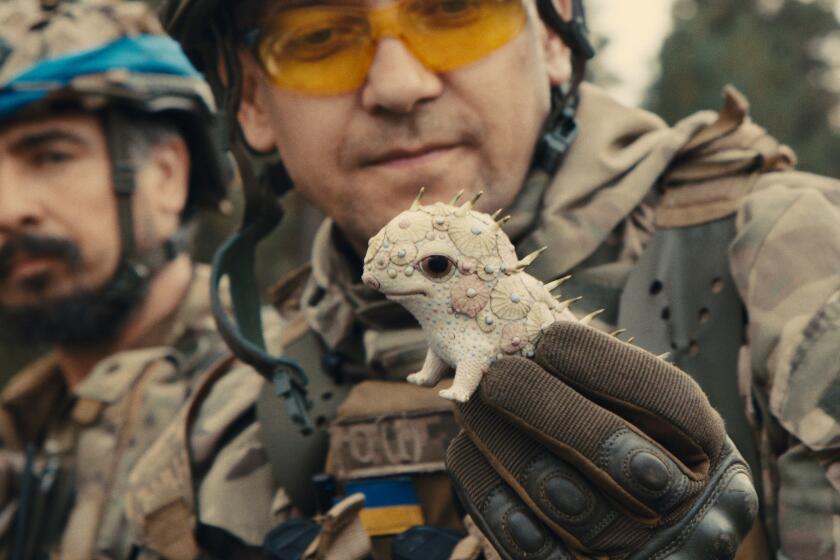Review: Dark Jung thing: ‘Come True’ is shadowy and inventive
- Share via
The Times is committed to reviewing theatrical film releases during the COVID-19 pandemic. Because moviegoing carries risks during this time, we remind readers to follow health and safety guidelines as outlined by the Centers for Disease Control and Prevention and local health officials.
Anthony Scott Burns’ “Come True” is a can-do, low-budget, sci-fi horror at its most inventive — and especially rewarding for the Jung at heart.
That’s as in pioneering psychoanalyst Carl Jung, whose ideas permeate the film but beneath the surface (where they belong!), so as not to get in the way of thehigh-quality creepiness.
Julia Sarah Stone plays Sarah, a teen who has left home for reasons that aren’t readily apparent. She’s sleeping in parks and getting around on her bike but sneaking back for essentials while avoiding her mom. Indicative of the film’s tendency to elide exposition, we just have to follow along and be in her experience — a smart, self-sufficient girl terrorized by her dreams.
In seeking shelter and possibly relief from relentless nightmares, Sarah participates in a university sleep study where researchers use new technology to attempt to gain insight into subjects’ dreams. What they’re doing specifically is hush-hush in the story; suffice to say, gaining that insight opens horrifying doors of perception for the teen.
“Come True” names its various chapters after key ideas from Jung’s theories of the relationship of the unconscious mind to the conscious world, known as archetypes (the Persona, the Animus or Anima, the Shadow and the Self) but doesn’t hit you over the head with explanations or hew too slavishly to their definitions. Rather, it expresses their echoes in subtle touches as it tracks deeper and deeper into the mystery Sarah unravels — though the Jungian concept of the collective unconscious does turn out to be an essential element.
Never fear, this isn’t like the Police’s song, “Synchronicity I,” with its frenetic barrage of tenets of Jungian philosophy. It’s more like the band’s “Synchronicity II,” a story song that applies tenets of Jungian philosophy to a nightmarish narrative.
Suffice to say, it’s bad news when the “Shadow” shows up in the context of a horror movie.
In only his second feature, do-it-all filmmaker Burns shows an admirably assured hand. The entire “Come True” team comes through to craft an immersive narrative despite a tiny budget. According to the press notes, the film’s entire shooting crew was made up of only five people — though that number could be doubled if you counted Burns and “production collaborator” Nicholas Bechard repeatedly.
The cinematography is excellent (Burns), if perhaps too enamored of blue filters. It effortlessly moves from the unremarkable but sleekly captured ordinary world into the depths of shadowy dream psyche. It melds with flowing editing, effective sound design, an atmospheric electronic score (Burns is one of the composers), overachieving production design and effectively deployed visual effects (Burns again) to create idiosyncratic cinematic language for the various realms.
In any genre, a distinct filmmaking voice and clever avoidance of cliches earns a closer look; perhaps even more so in the realm of sci-fi/horror. And no spoilers, but where “Come True” lands is extremely satisfying.
'Come True'
Not rated
Running time: 1 hour, 45 minutes
Playing: Starts March 12, Vineland Drive-in, City of Industry; and in general release where theaters are open; also on VOD
More to Read
Only good movies
Get the Indie Focus newsletter, Mark Olsen's weekly guide to the world of cinema.
You may occasionally receive promotional content from the Los Angeles Times.











